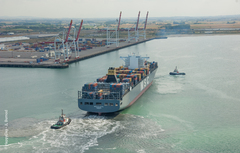- Homepage >
- Press >
- Press releases >
- Details of the press release
News detail
INCREASED VOLUMES OF FULL CONTAINERS AND PETROLEUM PRODUCTS PUSH TRAFFIC FIGURES UP
5th august 2013

After a difficult first quarter of 2013, as expected, traffic volumes in the port of Dunkirk have begun and consolidated their recovery since April, supported by full containers and refined products.
At mid-year 2013 (figures to the end of July), the total tonnage was 24.45 MT, down 11.5% over the same period in 2012, but still showing a strong recovery since April compared with the first quarter of 2013, which was badly affected at -15%.
While traffic was severely affected in the first quarter by the scheduled shutdown of the British Eon power plant, which has suddenly deprived the Port of nearly 3 million tonnes a year, the diversification in other sectors is slowly bringing volumes up again.
Petroleum products were up 4% at 3.73 MT (refined products) but other liquid bulks were down 42% to 493 KT, contributing to an overall drop of 6% in the liquid bulks sector. This fall was the result of the downturn in oils (-59%) and industrial alcohols (-42%).
Despite the encouraging level of reshipments to the European plants of the ArcelorMittal Group (+5%), ore traffic fell overall by 9% to 6.55% MT.
Coal imports remained satisfactory (up 1%) but exports were hard hit by the loss of Eon traffic.
In this early part of the year grain traffic posted an export volume of 476 KT (-3%) at this stage of the season.
At 8.9 MT (-10%), general cargoes are gradually making up for the differential at the start of the year, which was artificially maintained in 2012 by difficulties in the cross-Channel service at Calais and the temporary deployment of 4 ships at Dunkirk instead of 3. The situation has now returned to normal and the residual deficit (2012/2013) of RORO traffic at the end of July was only 11%.
The container sector has performed well, with a remarkable 9% rise in full containers since the start of the year and an increase of more than 7% in the number of container carrier calls thanks to the diversification of regular lines, particularly in shortsea transport.
This steady recovery is expected to continue in the second half of 2013.
Tél : +33 (0)3 28 28 78 78 - Fax :+33 (0)3 28 28 78 77








